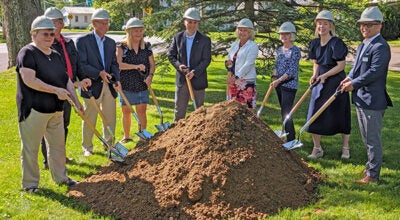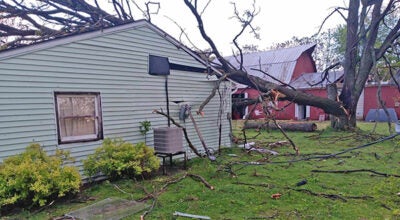Locomotives along the lakeshore
Published 11:52 pm Wednesday, September 7, 2011
Railroads were largely community efforts, contrary to the idealized image of Americans as rugged individual entrepreneurs.
Railroads represented “one of those cooperative ventures Americans usually do very well” — especially by the 1830s “mania” for “internal improvements,” Robert Myers of St. Joseph, curator of The History Center at Courthouse Square in Berrien Springs, led off The Museum at Southwestern Michigan College fall lecture series Wednesday evening with “Locomotives Along the Lakeshore,” about Berrien County railroads.
“You had to be on a railroad. Railroads were the lifeblood of your town,” Myers said, whether it endured or withered away, such as Hinchman, Scottdale, Eau Claire, Sodus, Hartman, Dayton, Three Oaks, Galien and Glendora, which had been known as Hill’s Corners.
Railroads caused the rift between north and south Berrien County — the latter very nearly became known as Jefferson County — and ultimately lost Berrien Springs the county seat to St. Joseph.
Niles’ “iconic” Richardsonian Romanesque depot was built in 1892 for Michigan Central to showcase the Garden City to thousands of Chicago visitors bound for the 1893 Columbian Exposition at the last major stop in Michigan.
It was “beautifully restored” in the early 1980s, appearing in such movies as “Continental Divide” and “Midnight Run.”
Niles was known as the Garden City for greenhouses overseen by a German master gardener. When trains stopped, women were presented with fresh flowers.
“I think it’s one of the prettiest stations in the state,” the historian and author said.
Trains spurred growth in Niles, which by 1940 had the New York Central classification yard, and a turntable when the railroads were huge employers pioneering such business practices as middle management.
Railroads “were enormous employers, like the auto industry became for us in the 1950s, ’60s and ’70s,” he said. “Niles had to build a new subdivision when they put the (rail car-sorting) classification yards there just to house all the workers. Besides the engineers, firemen, brakemen and conductors, you had to have people to maintain the train car rolling stock and track. You had station agents and telegraphers. Factories that turned out the locomotives. Steelyards that turned out the rails. Steam locomotives needed a lot of maintenance” before they gave way to diesel.
There was such a fierce rivalry between Niles in southern Berrien County and St. Joseph in the north, the joke went that if the latter landed a federal appropriation for a lighthouse, the former would want one, too.
Myers started with what became Michigan Central Railroad to trace the mania for internal improvements, which could also encompass canals and harbors for navigation.
Under “Boy Gov.” Stevens T. Mason, Michigan’s idea was to build three railroads to span the state, the Northern (Port Huron to the mouth of the Grand River, where Grand Haven is today; Central (Detroit over to St. Joseph); and Southern, from Monroe to New Buffalo.
While the Central was extended as far as Kalamazoo “in fits and starts,” the plan proved “overly ambitious” and never panned out, with the Southern darting down into Indiana enroute to Chicago.
One impediment was the “panic of 1837,” which generally collapsed the business climate.
“The state sold the railroad to private owners when it got to Kalamazoo,” Myers said. ”Private owners decided St. Joseph was not the place to go with this railroad unless you want it to go bankrupt. They wanted the railroad to go to Chicago, where the money and passengers were. So, from Kalamazoo it dropped south into Dowagiac and Niles, making a beeline for Chicago. It reached Niles in the fall of 1848, then continued across southern Berrien County. It made towns like Niles, Galien and Buchanan, which were actually formed right on the railroad. Niles went from a little village on the St. Joseph River and Chicago Road” as land values shot up and shipping rates shot down.
“Niles people were delighted,” Myers said. “Niles was the first major stop in Berrien County, then across the tier, Buchanan, founded in 1842, had grist mills and sawmills, taking advantage of the water power, but to ship lumber and grain was very expensive by water. Hardly practical. But when the railroad came, you could ship produce and manufactured goods. Factories start out using natural field and forest products, making lumber, flour and tool handles. Railroads allow you to ship in raw materials like iron ore to a foundry and to ship out manufactured goods.”
Dayton, west of Buchanan, was a thriving community created by rail’s arrival which by 1873 had a depot, a grist mill, a drug store, a wagon shop, a Methodist church and even a hotel, the Dayton House.
Three Oaks, also created by the railroad, made featherbone corsets and buggy whips out of turkey feathers.
Edward K. Warren is best known today by the dunes named for him.
Michigan Central finally reached New Buffalo in 1849 before leaving Michigan to make its way around the bottom of Lake Michigan and on to the Windy City.
The railroad turned New Buffalo into a “boomtown,” Myers said. “Property values skyrocketed, from $5 in 1848 to around $50 in 1849. A shipping company came in which ran across the lake to Chicago because the railroad still wasn’t completed. They had to get off in New Buffalo, eat in the restaurants, put up for the night and drink in the taverns and wait for the ship across. Only trouble was there was nothing to stop the railroad from continuing to build, which it did.
“In 1852, Michigan Central completes its tracks to Chicago. New Buffalo’s boom went bust. The town just collapsed. It wasn’t for a long time, until the 20th century, that it came back from a backwater burg. It was the first example in this area of the railroad having the power to make or break a town,” Myers said.
Michigan Central bypassing St. Joseph and rerouting through Niles meant it “stole” the railroad. Myers said in 1850 it was proposed in the Michigan Legislature to divide Berrien County into two counties, Berrien in the north and Jefferson to the south.
“This rivalry goes way back,” he said. “Various schemes tried to bring the railroad to St. Joseph, but most fizzled out” until 1869.
“Michigan had passed a municipal aid act which allowed villages and townships and so forth to issue public bonds to build a privately-owned railroad instead of a water works or a sewage system. Public money to build a private railroad, giving taxpayer dollars to private industry? Kind of like bailing out General Motors. The Supreme Court said that wasn’t constitutional, but St. Joseph acted in the meantime. All of the little towns on the lakeshore that really wanted a railroad got together and issued public bonds to build the Chicago and Michigan Lakeshore Railroad (C&MLSRR). They finished it up in early 1870. It ran from New Buffalo, where you could connect with Michigan Central, on up to St. Joseph, then over to Benton Harbor, Watervliet, Coloma and so forth. We went into the depression of 1873. There wasn’t one Great Depression in the 1930s. We had depression after depression, boom and bust. Why do you think we have a Federal Reserve? It went bankrupt and finally turned into the Chicago and West Michigan. The trains kept rolling. The St. Joseph depot was down below the bluff.”







